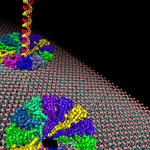Microbiology

For those who enjoyed our first set of bacteria art images, you will definitely want to check out Microbial Art.
www.microbialart.com

Parts of our genetic programs that determine programmed cell death in plants and animals are actually evolutionarily related and function in a similar way, according to an article in Nature Cell Biology.
Research has previously believed that animals and plants developed different genetic programs for cell death.
For plants and animals, and for humans as well, it is important that cells both can develop and die under controlled forms. The process where cells die under such forms is called programmed cell death. Disruptions of this process can lead to various diseases such as cancer, when…

One of the professors at my marine station retired, and is in the process of clearing out his lab. This has resulted in a sudden windfall of free stuff, some awesome (an invertebrate textbook so old it lists the phylum Vermes) and some completely useless (ancient test tubes of unknown contamination history).
The most awesome to date was a box of squid, fixed and embedded in plastic over ten years ago. These squid provided the data for the study which proved horizonal transmission of the symbiotic bacteria in the accessory nidamental gland.
I know, right? Isn't that amazing?
Um. Okay, let me…

An RNA-powered nanomotor has become the engine for an artificial pore able to transmit nanoscale material through a membrane, the next step in research on using nanomotors to package and deliver therapeutic agents directly to infected cells. Eventually this could enable use of nanoscale medical devices to diagnose and treat diseases.
In a study led by University of Cincinnati (UC) biomedical engineering professor Peixuan Guo, PhD, members of the team inserted the modified core of a nanomotor, a microscopic biological machine, into a lipid membrane. The resulting channel enabled them to…

A new study from the Sahlgrenska Academy at the University of Gothenburg says middle-aged women who have large abdominal fat cells are at higher risk of developing type 2 diabetes compared to women with smaller fat cells. Waist circumference divided by body height can also be used to determine which women are at risk.
The study is based on the extensive population study of women in "Gothenburg Kvinnoundersökningen i Göteborg".
"The results indicate that large fat cells contribute to the development of type 2 diabetes, and we will now begin investigating the mechanisms behind this…

The smell of 'death' that repels insects turns out to be a truly ancient signal for avoiding disease or predators, says David Rollo, professor of biology at McMaster University in the journal Evolutionary Biology.
What do the death stench of corpses of from insects to crustaceans all have in common? A blend of specific fatty acids.
Because insects and crustaceans diverged more than 400-million years ago it is likely that most subsequent species recognize their dead in a similar way, that the origin of such signals was likely even older, and that such behavior initially occurred…

Microbiologists from the University of Essex have shown they can break down and remove toxic compounds from crude oil and tar sands using microbes. These acidic compounds persist in the environment, taking up to 10 years to break down.
Tar sand deposits contain the world’s largest supply of oil. With dwindling supplies of high quality light crude oil, oil producers are looking towards alternative oil supplies such as heavy crude oils and super heavy crudes like tar sands. However, the process of oil extraction and subsequent refining produces high concentrations of toxic by-products.
The…

Bacteria that manufacture hydroxyapatite (HA) could be used to make stronger, more durable bone implants. Professor Lynne Macaskie from the University of Birmingham this week (7-10 September) presented work to the Society for General Microbiology’s meeting at Heriot-Watt University, Edinburgh.
Using Serratia bacteria, the research showed that the bacterial cells stuck tightly to surfaces such as titanium alloy, polypropylene, porous glass and polyurethane foam by forming a biofilm layer containing biopolymers that acted as a strong adhesive. The HA coating then builds up over the surface. For…

Probably not. However, sometimes when I have too much to do, I actually get more done... Scientist's in general seem to love to rant about how busy they are. Especially to each other. Perhaps its just a form of one upping the other guy, but lately I've been thinking that perhaps the reason it seems like we're always working is that we're always thinking. Since that is basically what we do for a living (think that is), then maybe it just feels like we're always working.
Actually what I get paid to do is think, do experiments and write. Perhaps more…
Protein S, a well-known anticoagulant protein, also contributes to the formation and function of healthy blood vessels, say researchers at the Salk Institute for Biological Studies. They found that mice lacking protein S suffered massive blood clots, but also had defective blood vessels that allow blood cells to leak into the surrounding tissue.
There are more than 200 known human mutations and polymorphisms in the gene coding for protein S, which was arbitrarily named after Seattle, the city of its discovery. The resulting deficiencies predispose carriers to deep venous thrombosis,…